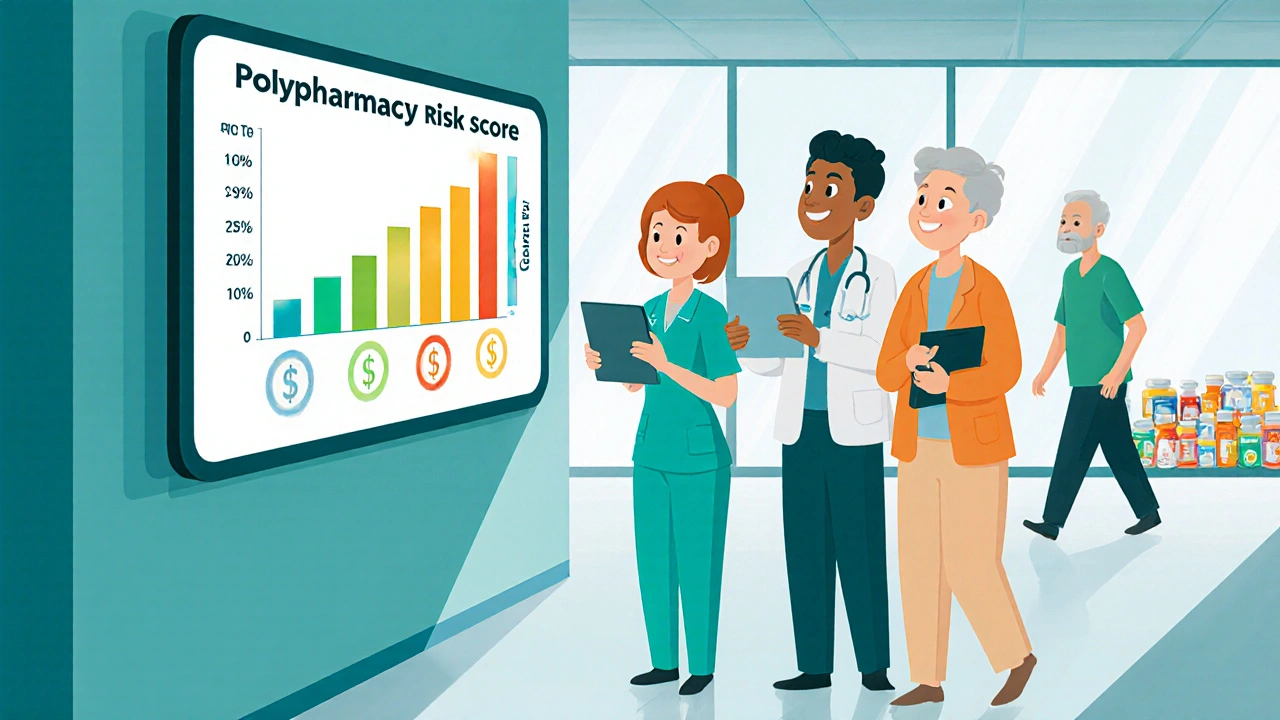Polypharmacy Risk Calculator
The calculation starts at the baseline risk for 5 medications (polypharmacy definition).
Current Risk Level
Recommended Action
Older adults often juggle a cocktail of pills, and each extra tablet raises the chance of a slip, a fall, or a hospital stay. Polypharmacy is the routine use of five or more medications, a pattern that now touches more than 40% of people aged 65 and older in the United States. When the medication list balloons, the risk of adverse drug events (ADEs) climbs dramatically, and preventable hospitalizations surge. This article walks through the most proven ways to trim down unsafe drug regimens, keep the medicines that truly matter, and ultimately lower the rate of adverse outcomes.
Why Polypharmacy Turns Into a Safety Crisis
Every added drug bumps the odds of a harmful interaction by roughly 8%, regardless of the drug class. A 2018 study in the Journal of the American Geriatrics Society linked taking more than four medications with a 30‑50% higher chance of injurious falls. That translates to thousands of older adults ending up in emergency rooms each year.
Beyond falls, polypharmacy fuels medication‑related hospital admissions, which account for about 27.7% of all inpatient stays among seniors (Institute for Safe Medication Practices, 2022). The culprits are often potentially inappropriate medications-drugs that provide little benefit at the cost of side‑effects, especially when life expectancy is limited.
Core Strategies: From Review to Deprescribing
Experts agree that the first step is a systematic medication review. Comprehensive Medication Review (CMR) comes in three flavors:
- Type I: Review the prescription list only.
- Type II: Add an adherence assessment.
- Type III: Include a face‑to‑face (or video) consultation that looks at clinical conditions, patient goals, and functional status.
Only Type III CMRs have shown a clear cut in readmissions-an 18.3% reduction in unplanned hospital returns (JAMA Network Open, 2023). The extra time spent listening to the patient pays off.
Once the review is done, the next move is deprescribing: a deliberate, monitored withdrawal of drugs that no longer fit the patient’s health goals. Deprescribing isn’t about stopping everything; it’s about sculpting a safer, more effective regimen.
Decision‑Support Tools That Make a Difference
Clinicians rely on validated criteria to spot high‑risk meds. The most widely used are:
- Beers Criteria (updated 2023 by the American Geriatrics Society).
- STOPP/START criteria (v3, 2021) - a European tool that flags both over‑ and under‑prescribing.
- FORTA list (Fit fOR The Aged) - focuses on drug appropriateness across disease states.
STOPP/START and FORTA have both demonstrated real‑world improvements in clinical endpoints, whereas Beers is more of a safety checklist. Pairing any of these tools with an electronic health record (EHR) decision‑support module lifts appropriate deprescribing rates by nearly 30% (JAMA Internal Medicine, 2022).
Evidence Snapshot: What the Numbers Say
| CMR Type | Key Outcomes | Reduction in Hospital Readmission | Average Time per Review |
|---|---|---|---|
| Type I | Medication list cleaned, minimal patient interaction | 0% (not significant) | 22 min |
| Type II | Includes adherence check, modest drug changes | 2% (ns) | 35 min |
| Type III | Full clinical interview, tailored deprescribing plan | 18.3% (p < 0.01) | 45‑60 min |
Beyond readmission rates, Type III CMRs cut medication‑related problems by 22.4% more than Type I (Clarkson et al., 2023). Mortality benefits are strongest in the 65‑79 age group (14.7% reduction) and taper off in the oldest cohorts.

Putting It Into Practice: A Step‑by‑Step Blueprint
- Gather a complete medication list. Use pharmacy claims, patient reports, and the Medication Reconciliation process. Expect to spend about 22.7 minutes per patient (University of Michigan, 2023).
- Run a validated tool. Apply STOPP/START (15‑20 minutes) or FORTA to flag high‑risk agents.
- Schedule a Type III CMR. Conduct a video or in‑person session, discuss goals of care, life expectancy, and patient preferences.
- Create a deprescribing plan. Prioritize drugs with no clear benefit, high fall risk, or duplicate therapy. Taper slowly for benzodiazepines, opioids, or antihypertensives to avoid withdrawal.
- Document and monitor. Update the EHR, set alerts for follow‑up labs, and arrange a check‑in after 2‑4 weeks.
- Engage the care team. Involve a clinical pharmacist under a Collaborative Practice Agreement (CPA) if your state permits. Pharmacist‑led reviews boost deprescribing rates by 37.6% (2025 Tandfonline study).
When resources are tight, telehealth can fill gaps-75% of pharmacist‑led visits in 2025 were virtual, showing the model’s scalability.
Economic Impact and Policy Landscape
Every comprehensive medication management episode saves roughly $1,872 per senior per year, mainly by averting costly hospital stays (McFarland et al., 2021). On a system level, reducing polypharmacy could shave off $30.1 billion annually from U.S. healthcare spending.
Policy is nudging providers toward action. Since 2024, Medicare’s Merit‑Based Incentive Payment System (MIPS) flags practices with more than 30% of patients on ten or more meds, penalizing them financially. The Veterans Health Administration’s GRECCs already report a 26.8% drop in potentially inappropriate meds, underscoring how payment reforms can drive change.
Quick Takeaways
- Polypharmacy (≥5 meds) raises ADE risk by 8% per extra drug.
- Type III CMRs-full clinical interviews-cut readmissions by ~18%.
- STOPP/START and FORTA are the only tools proven to improve hard outcomes.
- Pharmacist‑led reviews under CPAs boost deprescribing by nearly 40%.
- Effective programs save ~$1,900 per patient annually.

Common Pitfalls and How to Avoid Them
Pitfall 1: Stopping a medication without a taper. Solution: Use gradual dose reductions, especially for CNS depressants.
Pitfall 2: Ignoring under‑treatment. Solution: Apply STOPP/START’s “START” component to add needed drugs (e.g., statins for diabetic patients).
Pitfall 3: Relying on medication count alone. Solution: Pair count reduction with clinical context; avoid inappropriate deprescribing, which occurred in 12.8% of count‑only approaches.
Future Directions
Artificial‑intelligence risk scores are arriving fast. Epic’s “Polypharmacy Risk Score” (2024) predicts ADEs with 87.3% accuracy, enabling proactive alerts before a patient even steps into the clinic.
Next‑generation Beers Criteria (v2026) will embed deprescribing algorithms, making it easier for busy clinicians to act on high‑risk findings.
Next Steps for Your Practice
- Train at least one staff member on STOPP/START or FORTA (12‑18 hours total).
- Integrate a Type III CMR workflow into your chronic‑care visits.
- Negotiate a CPA with your local pharmacy board if possible.
- Track key metrics: number of meds per patient, ADEs, readmissions, and cost savings.
- Review performance quarterly and adjust the process.
Frequently Asked Questions
What defines polypharmacy in older adults?
Most researchers, including the American Geriatrics Society, define polypharmacy as the regular use of five or more prescription medications. The threshold is a practical guide, not a strict rule, and helps clinicians flag patients who may need a medication review.
How does a Type III CMR differ from simpler reviews?
A Type III CMR adds a personal interview-either in‑person or via video-where the clinician explores the patient’s health goals, functional status, and any side‑effects. This added dialogue is what drives the 18% reduction in readmissions seen in recent studies.
Can deprescribing be done safely for someone on ten meds?
Yes, but it must be systematic. Start with a medication‑reconciliation, use STOPP/START or FORTA to identify high‑risk drugs, then taper or discontinue them slowly while monitoring for disease flare‑ups. Involving a pharmacist under a CPA dramatically improves safety.
What are the biggest barriers practices face?
Time constraints (most primary‑care visits allot less than five minutes for medication review) and limited reimbursement are top hurdles. Telehealth and pharmacist‑led models help overcome these by spreading the workload.
How much can a practice expect to save?
Comprehensive medication management saves roughly $1,800‑$2,000 per senior each year, mainly by cutting avoidable hospitalizations and emergency‑room visits.


Anurag Ranjan
October 26, 2025 AT 20:33When you start a medication review think of it as a quick inventory of everything a patient is taking. Grab the pharmacy claims, the bottle labels, and the patient’s own list, then line them up side by side. Running a STOPP/START scan usually takes about fifteen to twenty minutes and flags the biggest red flags. The goal is to cut the pill count without compromising disease control.
James Doyle
November 8, 2025 AT 14:06The moral imperative of deprescribing in geriatric populations cannot be overstated, as each extraneous pharmacologic agent constitutes a latent vector for iatrogenic morbidity. Contemporary health systems, entrenched in a pharmaceutical‑centric paradigm, often incentivize polypharmacy through volume‑based reimbursement structures, thereby perpetuating a cycle of unnecessary drug exposure. The evidence hierarchy unequivocally demonstrates that Type III comprehensive medication reviews, which integrate patient‑centered goal elicitation with evidence‑based decision support, produce a statistically significant reduction in readmission rates, approximating an 18 % relative decrement. Moreover, the pharmacodynamic and pharmacokinetic perturbations inherent to advanced age amplify the probability of adverse drug events, rendering each additional molecule an exponential risk factor. Clinical guidelines such as STOPP/START and FORTA provide algorithmic scaffolding that transcends the simplistic medication count metric, facilitating a nuanced appraisal of therapeutic appropriateness. It is incumbent upon clinicians to operationalize these instruments within an interoperable electronic health record environment, thereby enabling real‑time alerts and stewardship dashboards. When the deprescribing algorithm is deployed with interdisciplinary collaboration-pharmacists, primary care physicians, and geriatric specialists-synergistic effects emerge, culminating in cost savings that approximate $1,800 per beneficiary annually. The ethical dimension of this practice dovetails with the principle of non‑maleficence; it is ethically indefensible to perpetuate drug regimens that no longer confer net benefit. Furthermore, patient autonomy is respected when clinicians transparently discuss the risk‑benefit calculus and incorporate personal health goals into the therapeutic plan. While some practitioners balk at the perceived increase in visit time, the cumulative downstream resource utilization-emergency department visits, hospital admissions, and post‑acute care-far outweighs the marginal time investment. Institutional policies, such as Medicare’s MIPS penalties for excessive medication burden, are beginning to align financial incentives with best practice, incentivizing adoption of structured medication reconciliation pathways. Nevertheless, cultural inertia within certain specialties remains a formidable barrier, necessitating targeted educational interventions and mentorship models to cultivate a deprescribing mindset. Ultimately, the convergence of robust clinical evidence, sophisticated decision‑support technologies, and a patient‑first ethos coalesces to forge a sustainable strategy for mitigating polypharmacy‑related harm.
Edward Brown
November 21, 2025 AT 07:40What most people don’t realize is that the surge in polypharmacy is not merely a clinical accident but a calculated maneuver by the pharmaceutical oligarchy to lock seniors into perpetual consumption. The rollout of AI‑driven risk scores like Epic’s so‑called “Polypharmacy Risk Score” masquerades as patient safety while feeding massive data streams back to drug manufacturers. By flagging only the most obvious interactions, these algorithms leave the subtler, profit‑driven prescribing patterns untouched, ensuring a steady flow of revenue. It’s a reminder that every new tool can be weaponized, and clinicians must stay vigilant against hidden agendas.
ALBERT HENDERSHOT JR.
December 4, 2025 AT 01:13Excellent synthesis of the evidence, thank you for pulling together such a comprehensive guide. The step‑by‑step blueprint aligns perfectly with a collaborative practice model and should be easy to integrate into most primary‑care workflows. I especially appreciate the emphasis on documenting and monitoring outcomes; that feedback loop is crucial for continuous improvement. Keep up the great work, and let’s keep sharing best practices! :)